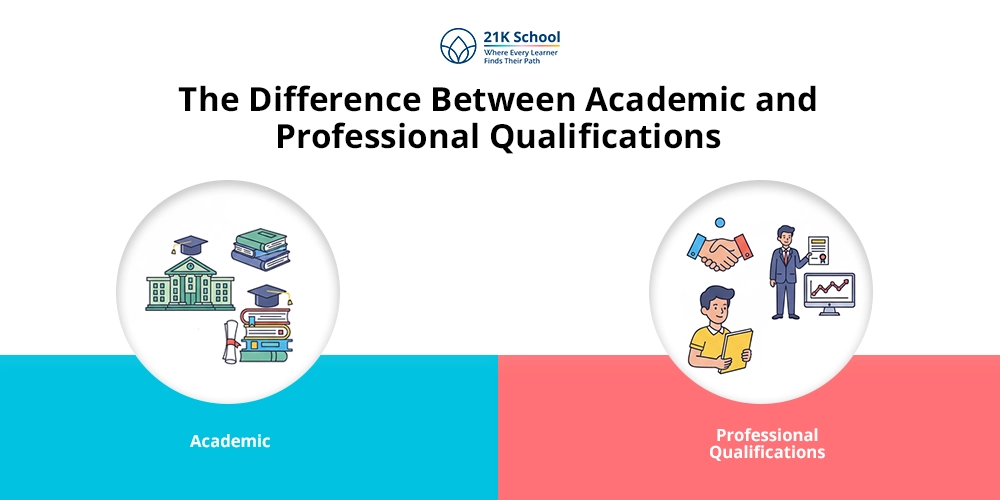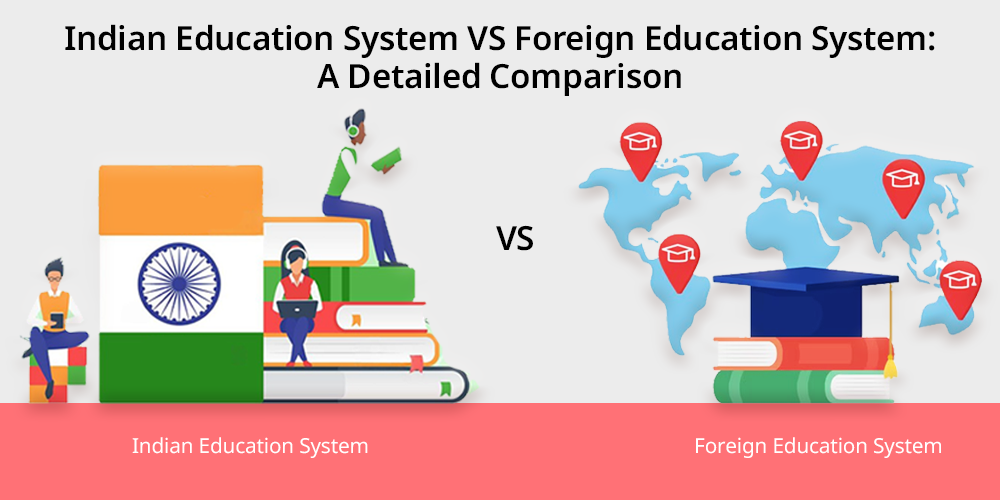
Have you ever thought about which education system is more comfortable and provides quality education?
Both the foreign and Indian educational systems are well-liked in India and other nations, but they differ in certain ways. The Indian education system is more structured and emphasises passive learning that focuses on theoretical knowledge.
On the other hand foreign education system provides learning that emphasises practical and skill-based education. The Indian education system and the foreign education system both follow different aspects of education, such as fees, curriculum, syllabus, faculty, study materials, etc.
Indian schools use a rigid curriculum with a focus on textbooks and traditional learning methods whereas foreign education provides a flexible curriculum that also provides them with personalized learning
Various online schools and virtual learning platforms provide education to students who abide by the Indian and foreign education system. While admitting students to schools, it is essential to evaluate the differences between the Indian and Foreign education systems.
Contents
- What is the Indian Education System?
- What is the Foreign Education System?
- Difference Between the Indian Education System and the Foreign Education System
- Advantages of the Indian Education System
- Disadvantages of the Indian Education System
- Advantages of Foreign Education
- Disadvantages of the Foreign Education System
- Wrapping Up
What is the Indian Education System?
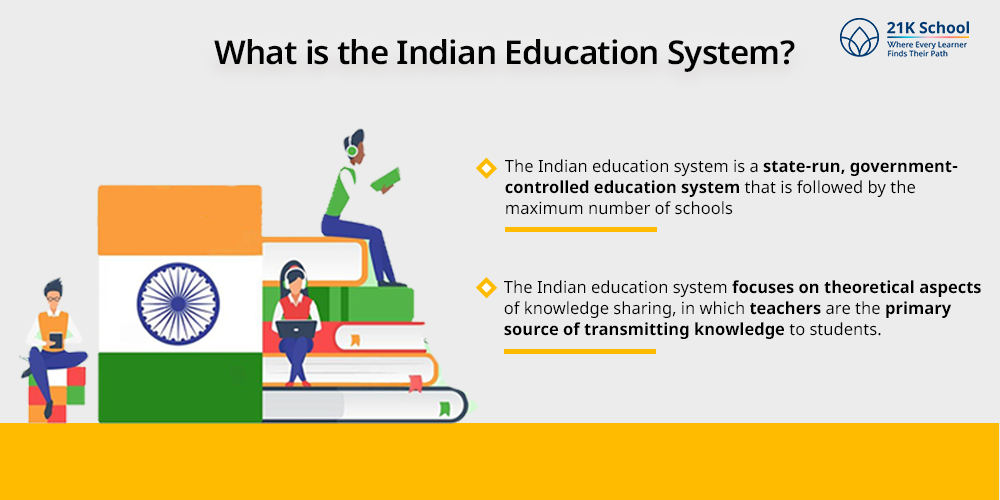
The Indian education system is a state-run, government-controlled education system that is followed by the maximum number of schools. The Indian education system focuses on theoretical aspects of knowledge sharing, in which teachers are the primary source of transmitting knowledge to students.
The Indian education system uses theoretical aspects which emphasise on memorisation of concepts and facts. In the Indian education system, the performance of students is measured through exams and formative assessment tools
The Indian education system provides a structured learning environment where children can select their courses and subjects. However, the Indian education system has some limitations that prevent them from developing interdisciplinary skills.
The National Education Policy NEP 2024 focuses on vocational and skill based learning to provide students with hands-on experience as well as promotes experiential learning
What is the Foreign Education System?
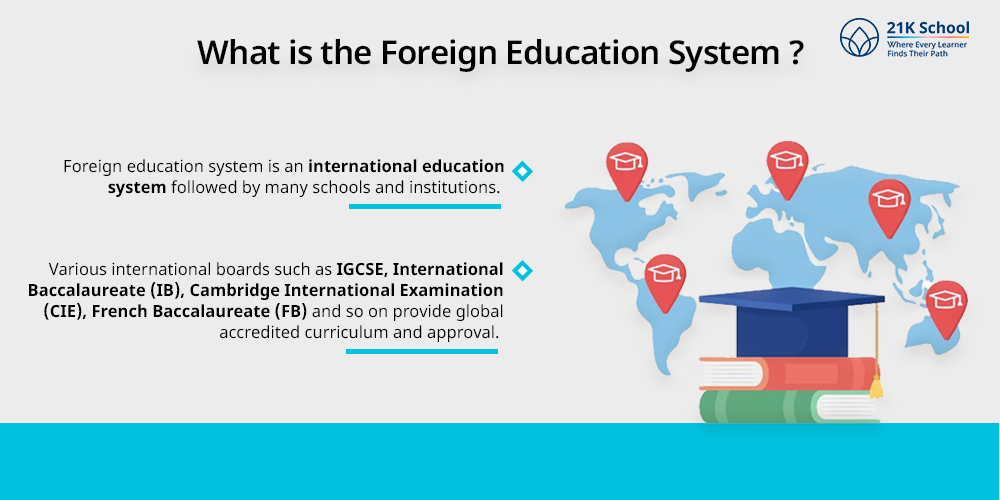
Foreign education system is an international education system followed by many schools and institutions.
Various international boards such as IGCSE, International Baccalaureate (IB), Cambridge International Examination (CIE), French Baccalaureate (FB) and so on provide global accredited curriculum and approval.
The foreign education system focuses on practical skills and emphasises on problem-solving skills , creative thinking skills and critical thinking skills as well.
The foreign education system allows students to acquire hands-on experience through project works, internships, hands-on learning and so on.
In order to explore various fields and build a distinct skill set, the foreign education system also enables students to tailor their degrees to their interests and professional objectives.
The foreign education system provides students with flexible and diverse education, which enhances their critical thinking skills and creativity.
Difference Between the Indian Education System and the Foreign Education System
There are differences between the educational systems in India and other countries. The Indian education system is widely used in every state of India, whereas the foreign education system is limited.
Each system has its own pros and cons of its own. It is essential for parents and students to make wise decisions. Below, you can check the detailed differentiation between the Indian education system and the foreign education system.
| Aspect | Indian Education System | Foreign Education System |
| Performance and Assessment | The Indian educational system primarily uses assessments to determine a student’s performance and grades. Monthly evaluations and semester tests are administered by universities, and they account for at least 70% of final scores. | In the foreign education system, the majority of the performance is measured with the extracurricular activities and assignments such as project work, research opportunities, seminars, essays and others. |
| Curriculum and Specialisation | The curriculum of the Indian education system is structured and doesn’t provide much flexibility. In the Indian education system, students have to select one specialisation and have to study it for an academic year, which limits the opportunities to explore different fields. | The curriculum of the foreign education system is flexible and provides multiple course options. In which students can choose the specialisation according to their interest and career goals. It gives independence to students through which they can explore different fields and develop interdisciplinary skills. |
| Career Opportunities | The Indian education system provides various career opportunities in the field of health engineering, data centre, UX/UI designer, full stack developer, digital marketer and so on. The Indian education system also focuses on vocational and skill-based education to enhance employability. | The foreign education system provides global career opportunities, where students can find international job opportunities in the field of engineering, marketing, finance, the healthcare sector, banking, etc. |
| Teaching Strategies | The Indian education system uses the traditional method of teaching and learning in which teachers are the primary source for transmitting information. In order to promote learning and uphold classroom decorum, teachers engage directly with their students. | In the foreign education system, teachers use engaging and interactive study lessons which encourage students’ participation in the teaching and learning process. The foreign education system also focuses on using technology to enhance the learning outcomes of students. |
| Extracurricular Activities | The Indian education system focuses more on theoretical aspects, due to which it focuses less on extracurricular activities. This hampers the creativity of children and limits their exploration. | The foreign education system mostly focuses on practical approaches and extracurricular activities such as project work, seminars, group activities, and so on. |
| Fee Structure | The fee structure of the Indian education system depends on the type of courses and educational institutes. The tuition fees of the Indian education system are very low compared to foreign education systems. | The fee structure of the foreign education system is higher than compared to the Indian education system. The fees for international degrees, especially from developed countries such as the USA, Canada, and France, are much higher. |
| Admission Procedure | The admission procedure of the Indian education system is simple and depends on exams. To take admission into universities for UG courses, students have to clear their 10+2 exams with a minimum of 50 to 60% | The admission process of the foreign education system is complicated and lengthy. To take admission, students have to clear their exams in science and commerce backgrounds with a minimum of 65%. In postgraduate they have to pass their exams with a GPA of over 3.0. Even students have to clear the English proficiency test. |
| Grading System | The Indian education system uses a 10-point grading system, along with that it also uses a letter grading system from letter A to F. Where letter A is outstanding performance, and letter F means Fail. | The foreign education system uses a 4-point GPA system along with letter grades from A to F. The grade points are also provided on the basis of assessments, assignments, research, and project work. |
| Global Perspective | The Indian education system has a global perspective that is approved in many international countries. The system increases the internationalisation of Indian education as well as prepares a global curriculum. | The foreign education system has a global perspective and is approved by the majority of organisations, and educational institutions around the world accept and endorse foreign education programs. |
| Flexibility and Creativity | The Indian education system is rigid and has limited flexibility. The Indian education system mostly focuses on the theoretical aspect with a structured learning environment. The theoretical aspect limits creativity in students. | The foreign education system provides a flexible and customised learning environment. This system focuses on the practical aspect of learning, which allows individuals to enhance their creative thinking skills. |
Advantages of the Indian Education System

The Indian education system has lots of benefits that allow students to achieve their future goals. The Indian education system focuses on promoting lifelong learning among students. The Indian education system is considered as affordable as compared to foreign education systems.
The Indian education system has easy accessibility through which every student can connect with others.
1. Affordable
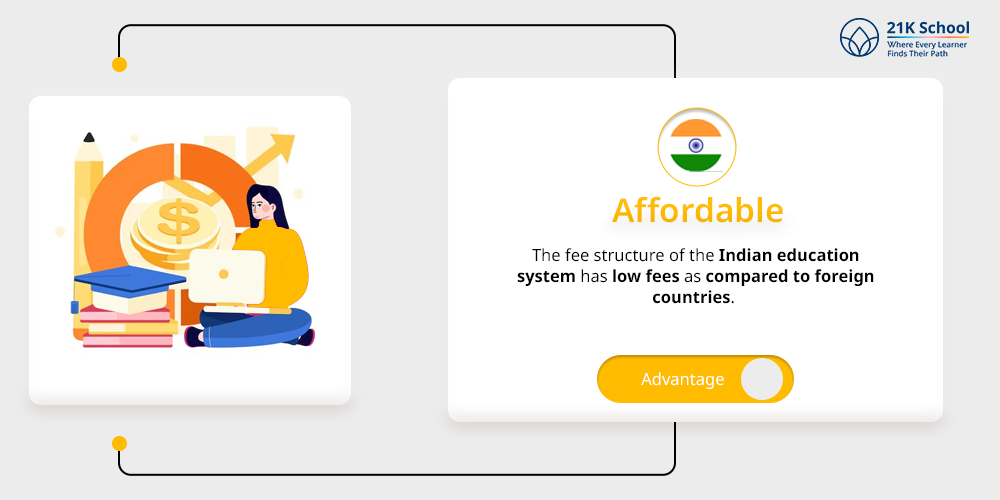
The Indian education system is affordable which makes it versatile and flexible for every student. The fee structure of the Indian education system has low fees as compared to foreign countries.
Due to the affordability of the Indian education system many children can take admission to schools. Even under the Right to Education Act (RTE) many schools provide free education to students.
2. Wide Range of Curriculum
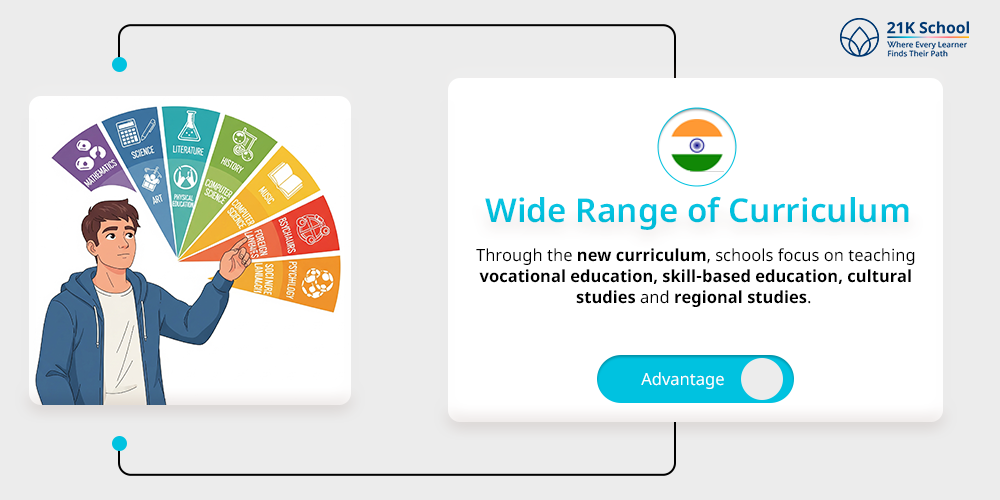
One of the major advantages of the Indian education system is it provides a wide range of curriculum. According to NEP 2024, schools focus on skill-based education, which comprises a modern curriculum.
Through the new curriculum, schools focus on teaching vocational education, skill-based education, cultural studies and regional studies. This helps in promoting problem-solving skills and creative thinking skills.
Through vast syllabus and curriculum students develop cultural awareness and enhance their knowledge retention.
3. Compulsory Education
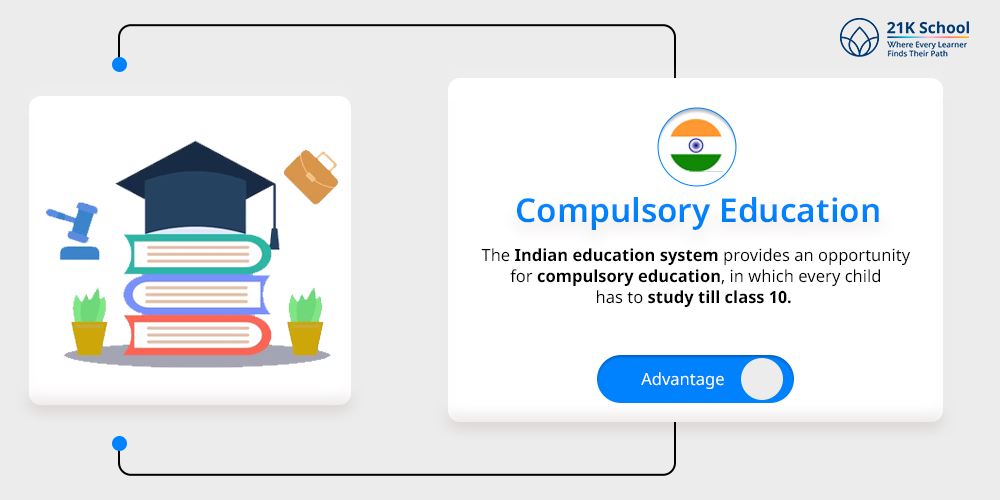
The Indian education system provides an opportunity for compulsory education, in which every child has to study till class 10. Under the RTE act every child has the right to clear class 10 examination in order to get employment and go for higher studies.
Through compulsory education every child gets an equal right to study, which enhances students’ participation in the teaching and learning process.
Under the RTE act many schools provide free education till class 5 which allows poor students to complete their education without any hindrances.
4. Cultural Values
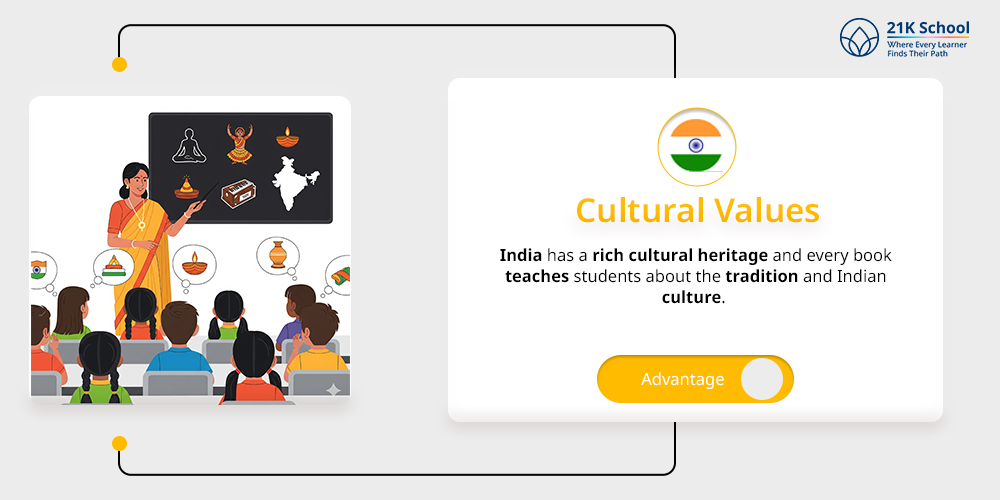
The Indian education system teaches about Indian cultural values and heritage. India has a rich cultural heritage and every book teaches students about the tradition and Indian culture.
Through this, students are exposed to different cultures, languages, religions, art form, history, and so on, which promotes cultural awareness among them. They gain the ability to appreciate different viewpoints and navigate a world that is becoming more interconnected.
5. Skill Development
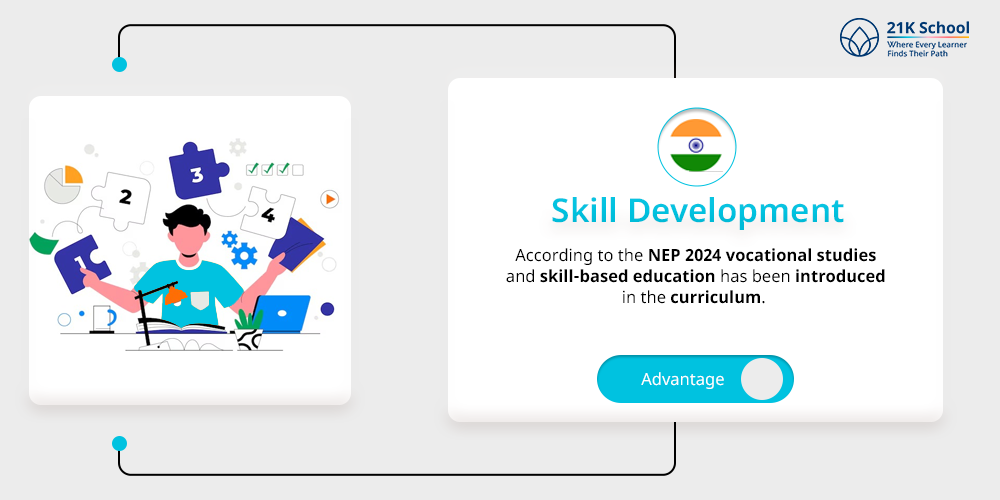
The Indian education system focuses on skill development of students. According to the NEP 2024 vocational studies and skill-based education has been introduced in the curriculum.
The main aim of this program is to prepare students for the global workforce, by providing them with adequate skill based programs.
These programs cover a vast range of areas such as group activities, simulations, workshops, project work, etc. This enables them to gain practical experience and aids in the development of useful skills.
Disadvantages of the Indian Education System

The Indian education system is known for its affordability, accessibility, cultural values and traditional learning methods.
However, along with so many benefits, the Indian education system still has so many disadvantages, such as outdated curriculum, old teaching and learning methods, lack of infrastructure, inadequate study plans and so on.
Due to this drawback, students lag their full potential of learning and make the teaching and learning process old.
1. Outdated Curriculum

The curriculum of the Indian education system relies on old curriculum with very limited updates.
Outdated curriculum makes it tough to keep pace with the current industry trends and knowledge, due to which students lag in today’s job market and are unable to meet the industry requirements. Traditional curriculum lacks flexibility to adapt according to the changing needs of the modern world.
2. Limited Networking Opportunities

One of the major drawbacks of the Indian education system is that it lacks networking opportunities. As due to traditional and one to one classes and limited practical approaches there is very less chance of networking with others.
Due to this students become less prevalent and unable to showcase their talents. This also hinders global collaboration due to which it limits future opportunities.
3. Lack of Infrastructure
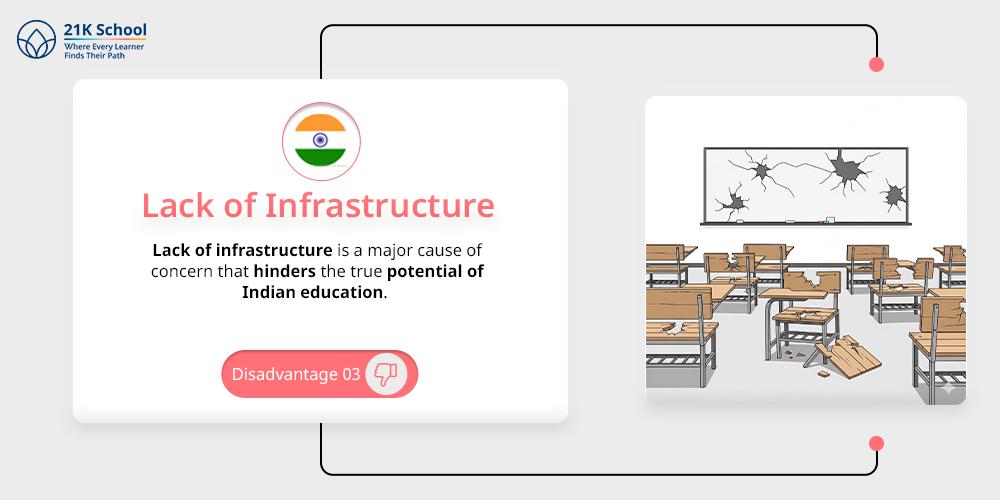
Lack of infrastructure is a major cause of concern that hinders the true potential of Indian education. Numerous schools in India have a problem with infrastructure. Lack of infrastructure is a major reason due to which students lose interest in learning.
One of the main causes of inadequate infrastructure which makes it difficult for schools to maintain their system is a lack of funding and support. This poses a significant challenge for Indian public schools.
4. Limited Practical Exposure
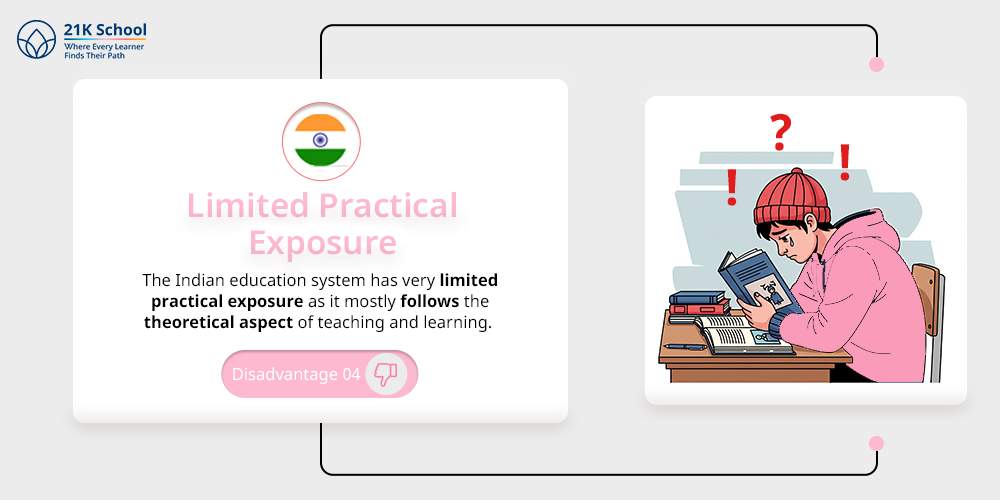
The Indian education system has very limited practical exposure as it mostly follows the theoretical aspect of teaching and learning.
In the Indian education system the main focus was laid on rote learning in which students are encouraged to memorise concepts to pass the examination. Due to limited hands-on experience, students find it difficult to get a deeper understanding of concepts and facts.
Due to limited practical exposure students find it difficult to apply knowledge into the real life scenarios.
5. Exam Stress
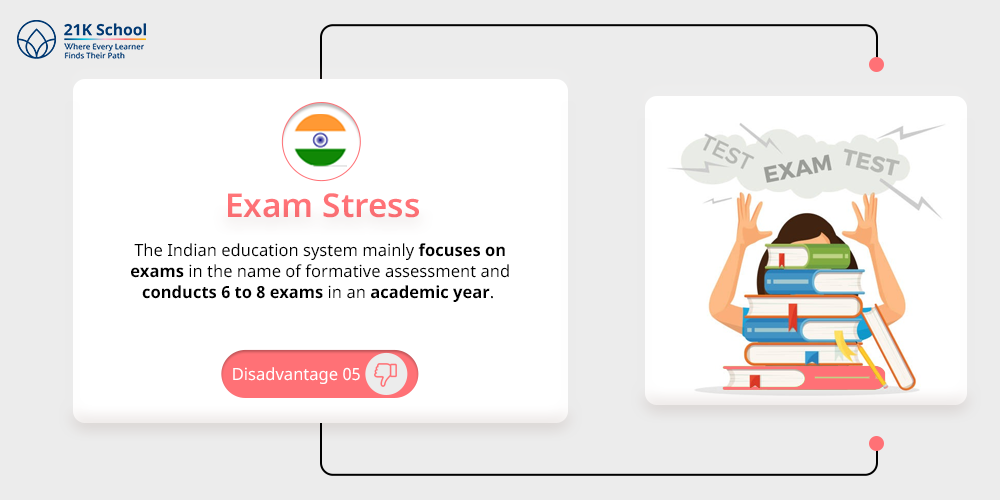
Exam stress is a major disadvantage in the Indian education system. The Indian education system mainly focuses on exams in the name of formative assessment and conducts 6 to 8 exams in an academic year.
Too many exams cause pressure on students due to which they develop exam stress and anxiety. Too much exam pressure hinders students’ potential and impacts their holistic development.
The Indian education system focuses on passive learning rather than a practical-based approach.
Explore in detail about Indian curriculum .
Advantages of Foreign Education
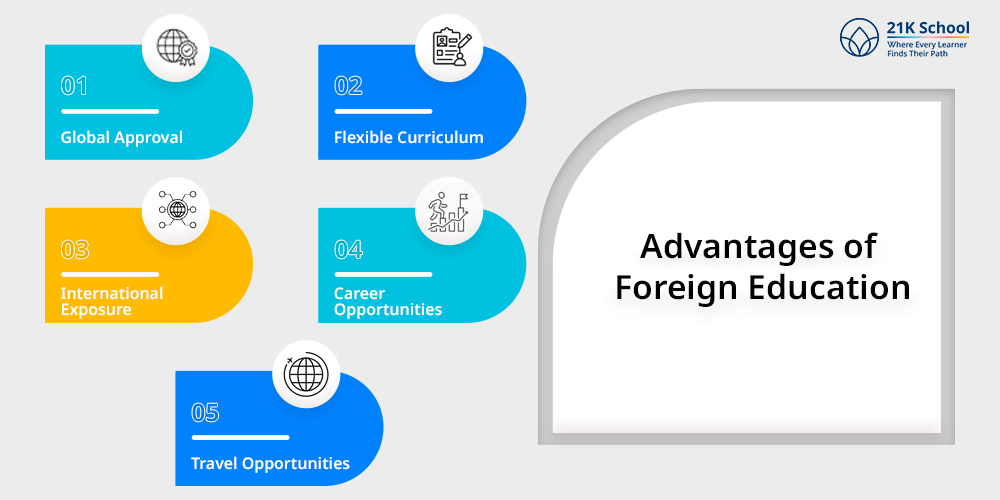
The foreign education system provides an opportunity to students to learn through hands-on experience. The foreign education system allows students to develop interdisciplinary skills and creative thinking skills.
The foreign education system focuses on practical learning rather than theoretical aspects of knowledge. This allows students to participate in the learning process in an effective and more engaging way.
The foreign education system emphasises on student exchange programs and online learning, which allows every student to develop collaboration skills
Below are the advantages of the foreign education system.
1. Global Approval
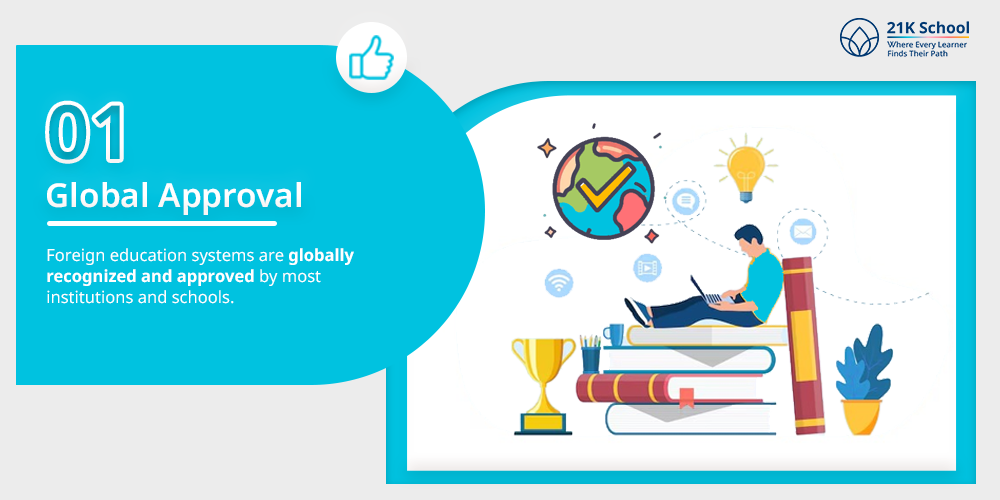
Foreign education systems are globally recognized and approved by most institutions and schools. This makes the foreign education system flexible and accessible to every student, through which they can adapt to the learning style of different boards and curriculum.
2. Flexible Curriculum
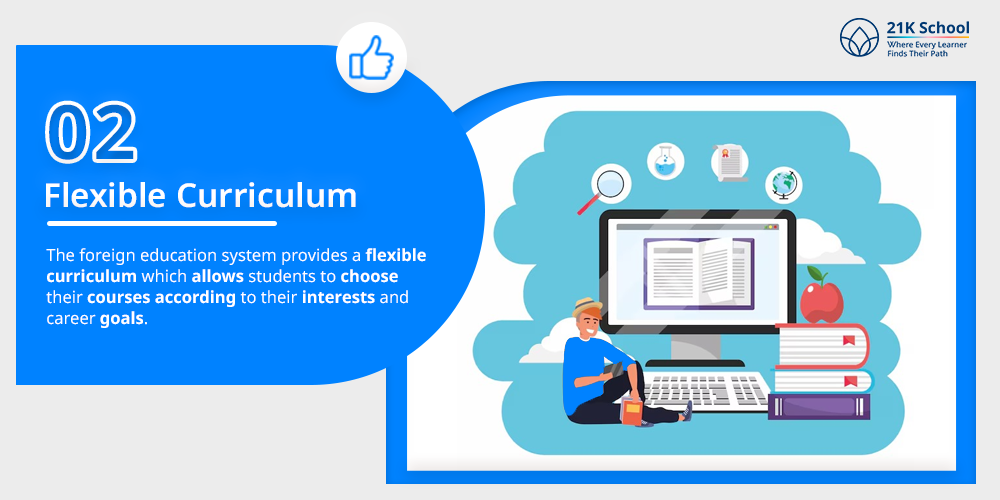
The foreign education system provides a flexible curriculum which allows students to choose their courses according to their interests and career goals. A flexible curriculum promotes holistic education and allows and provides specialised education based on the demand of the job market.
This provides a personalised learning experience and allows students to explore different fields. This encourages students to participate in the learning process and makes them independent learners.
3. International Exposure
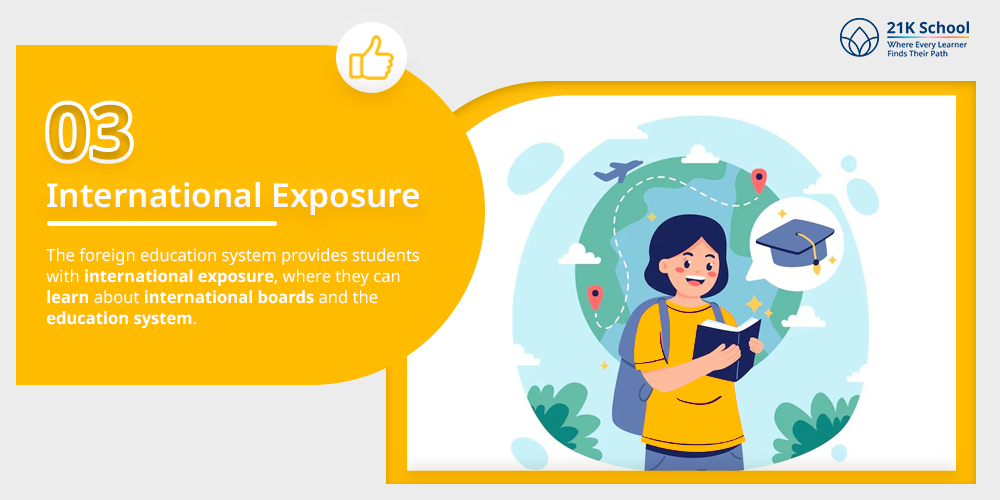
The foreign education system provides students with international exposure, where they can learn about international boards and the education system. International Exposure helps in promoting global collaboration among students, through which students can connect with others.
This allows them to share their ideas, viewpoints, thoughts, concepts, etc, as well as enhance career opportunities. This allows students to develop a global mindset and apply global knowledge according to the mindset.
4. Career Opportunities

One of the major advantages of foreign education system is that it provides students with career opportunities. Foreign education system allows students to gain practical experience which enables them to gain hands-on experience and training.
This allows them to develop social skills as well as advance their future career opportunities. Skilfull courses provide international exposure through which they understand the career prospects.
5. Travel Opportunities

Traveling is one of the most effective ways to explore the world and develop social skills. Foreign education system conducts exchange programs through which students can gain opportunities to study abroad and enhance their cultural experience.
Through international studies students can explore the world and develop deeper understanding.
Disadvantages of the Foreign Education System
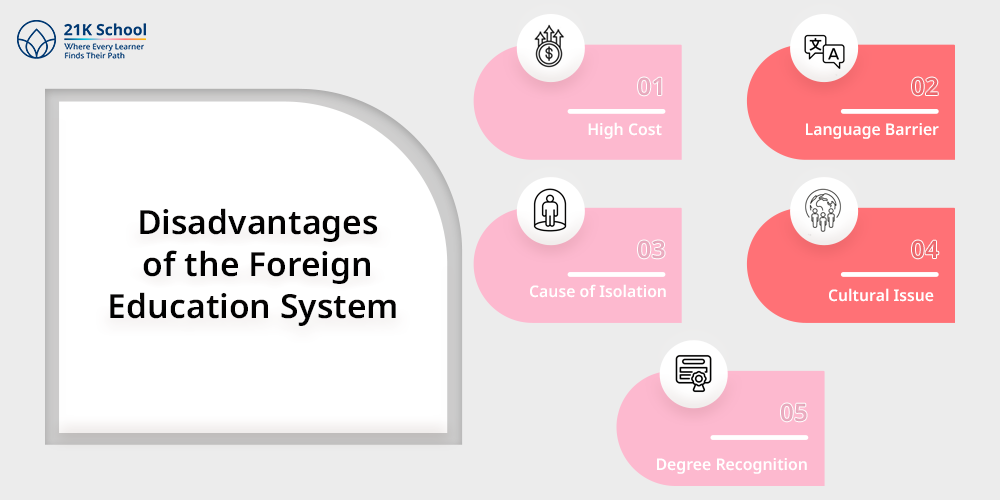
There is no doubt foreign education system has lots of benefits, but it still has so many disadvantages. Shifting to a new curriculum and environment is difficult for students due to which they find it difficult to adjust to the foreign education system.
Foreign education is still less popular as compared to the traditional education system in India. However, with e-learning evolution and the contribution of technology into education has made it popular in recent years. The following are the drawbacks of the foreign education system.
1. High Cost
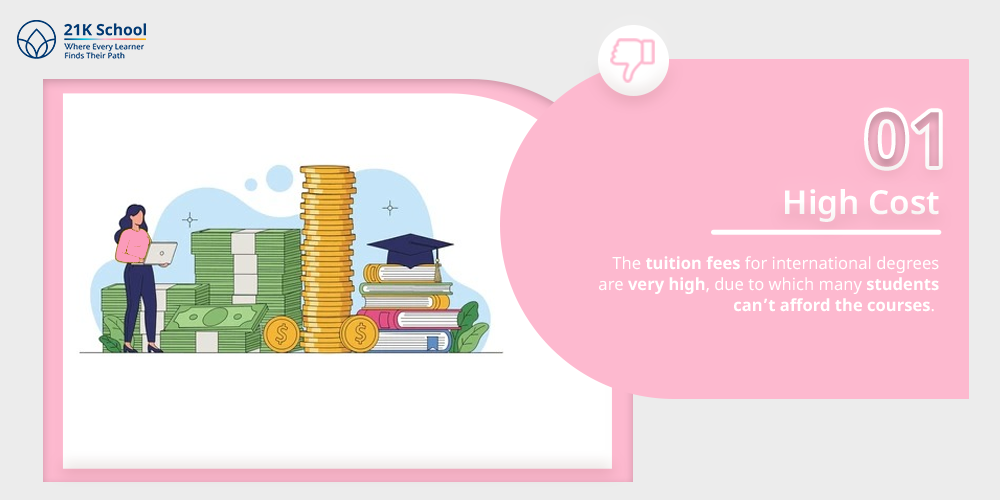
The foreign education system has a high cost as compared to the Indian education system. The tuition fees for international degrees are very high, due to which many students can’t afford the courses.
As this course combines practical elements and International resources for which they need to pay extra cost, many Indians are unable to pay such a high amount. The high cost of international degrees creates a barrier for students to attend foreign schools.
2. Language Barrier
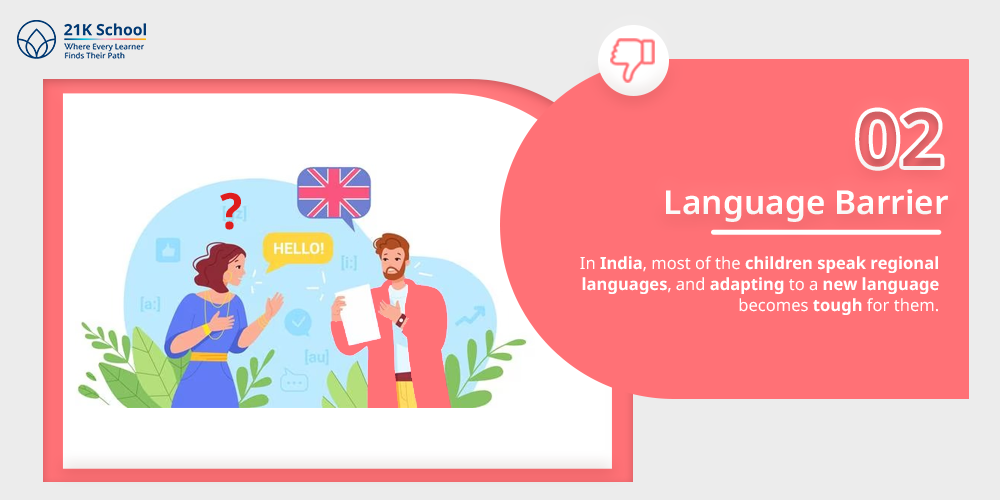
Language barriers are another disadvantage of the foreign education system. In India, most of the children speak regional languages, and adapting to a new language becomes tough for them.
Due to this reason, they are unable to communicate properly, which hampers their communication skills. A new learning environment with language barriers is a major challenge for students adapting to a foreign education system.
3. Cause of Isolation
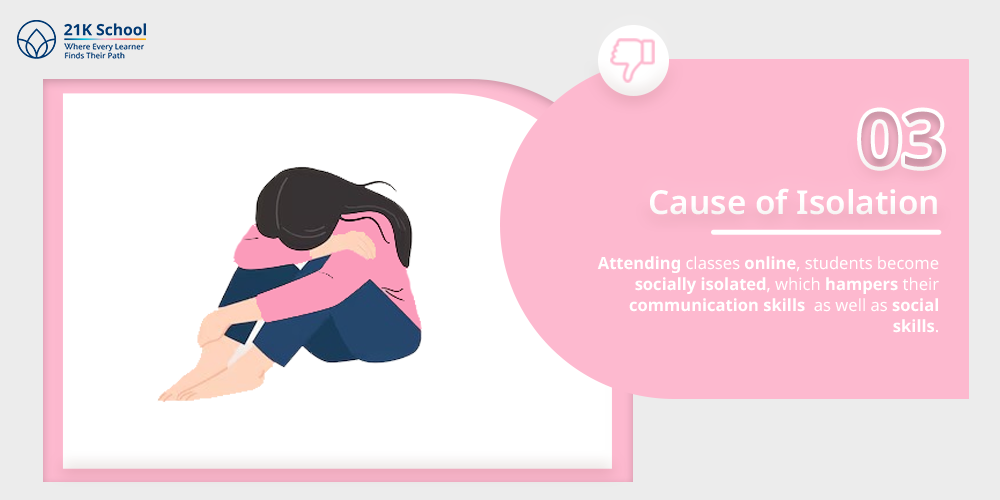
Most foreign degrees are provided through e-learning platforms , in which students have to attend classes in an online mode. Due to attending classes online, students become socially isolated, which hampers their communication skills as well as social skills.
These cause an impact on students’ well-being and their academic performance. For this reason, many students and their parents avoid accepting foreign education systems.
4. Cultural Issue
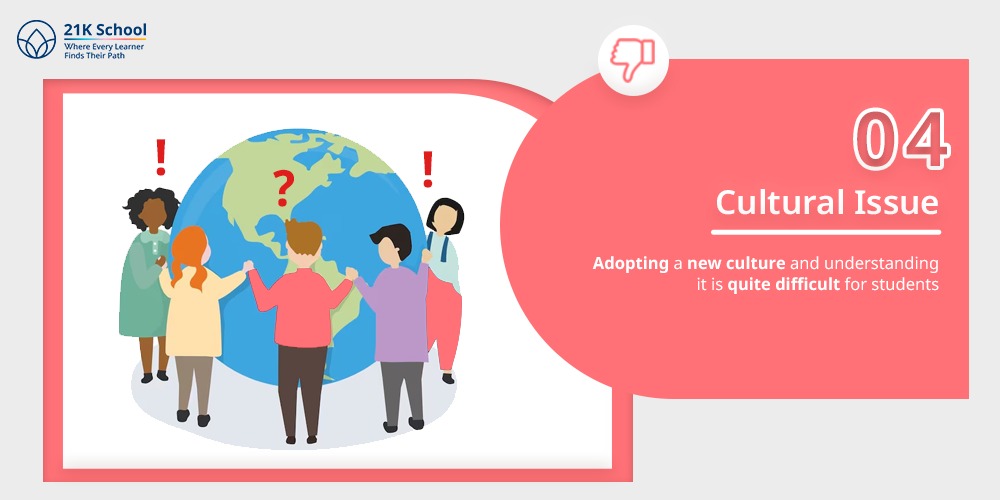
Cultural issues are another big reason in the foreign education system. Adopting a new culture and understanding it is quite difficult for students, as everyone has their own ethics, norms, beliefs, culture, etc.
These cause students to feel disorientation, and it is difficult for them to adjust with others. This hinders social-emotional learning among students and reduces their confidence.
5. Degree Recognition
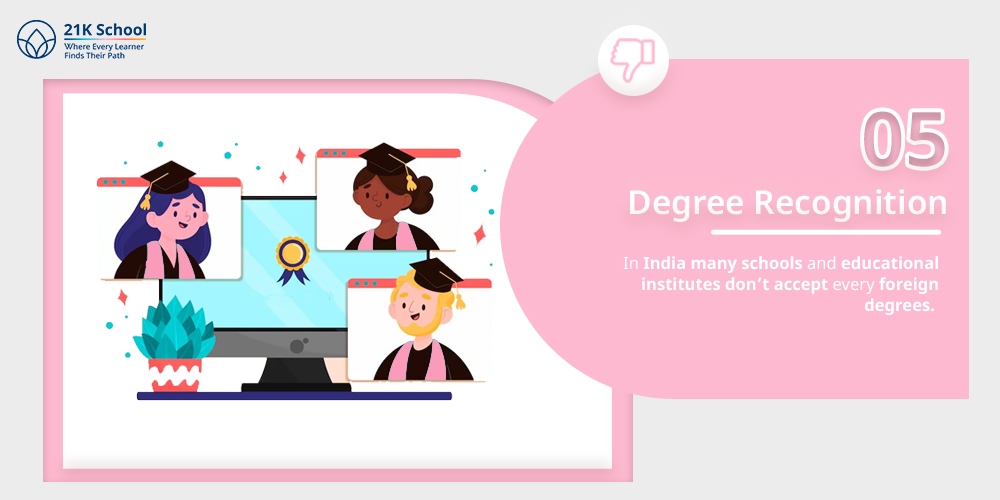
Degree recognition is another main factor of the foreign education system. In India many schools and educational institutes don’t accept every foreign degrees. Due to the rejection of foreign degrees students can’t complete their education.
Foreign education sometimes does meet the expectations of students and sometimes degrees become invalid.
Read on to learn more about the difference between Indian and British curriculum , and Indian vs American curriculum .
Wrapping Up
Both the foreign and Indian educational systems have special benefits and drawbacks that accommodate various learning objectives and styles. The affordability, well-organised curriculum, and focus on theoretical knowledge that can promote cultural values and skill development are characteristics of the Indian educational system.
Exam stress, inadequate practical experience, and out-of-date curricula are some of its difficulties, though.
On the other hand, the foreign education system frequently has high costs, language barriers, and possible cultural difficulties, but it also offers a flexible, internationally recognised curriculum that prioritises interdisciplinary learning, practical skills and international exposure.
The decision between these systems ultimately comes down to personal preferences, professional goals, and the unique requirements of students and their families. It is necessary to carefully weigh the advantages and disadvantages of each teaching strategy in order to make an informed choice.


